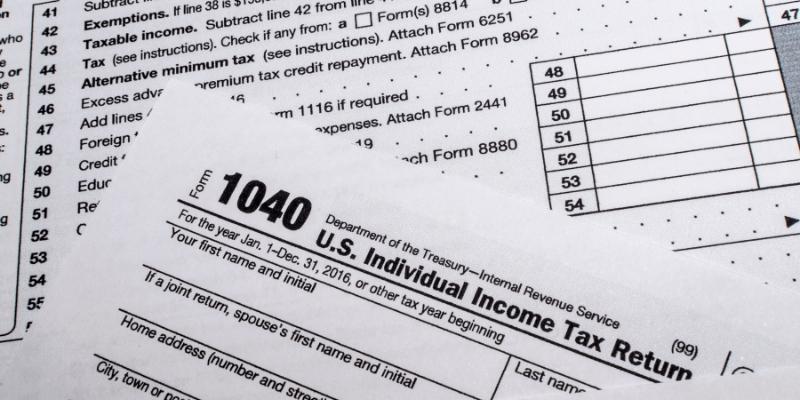The United States Internal Revenue Service's 1040 Form is one of the tax forms that taxpayers complete most frequently. It is necessary to have a solid understanding of the IRS Form 1040 instructions, including a comprehensive knowledge of the form's fundamentals, because so many individuals are required to complete it annually.
Form 1040, issued by the Internal Revenue Service (IRS), is one of the official documents taxpayers in the United States can use to file their annual income tax returns. There are several different versions of the IRS Form 1040. The federal form 1040 has undergone several revisions in the most recent years.

What Is A 1040 Form For?
Taxpayers figure out their taxable income and the amount of tax that should be paid on that income using the federal Form 1040. Calculating your Adjusted Gross Income (AGI), one of the first phases, requires you to declare your entire income first and then claim any permissible modifications, also referred to as above-the-line deductions. Your adjusted gross income, or AGI, is a vital statistic to know since it determines the limits of numerous credits and deductions.
Your adjusted gross income for the 2021 tax year is reported on Form 1040, Line 11. Whether the standard deduction or total itemized deductions from Schedule A can help you bring that number down even further. Included in the list of expenses that qualify as itemized deductions are state and local income taxes or sales taxes, interest on a mortgage, medical expenses, and gifts to charitable organizations.
If your itemized deductions don't add up to more than your filing status's standard deduction, reduce your taxable income by using the standard deduction instead. It holds even if you itemize your deductions. When 2018 rolls around, exemption deductions will be phased out and replaced with increased child tax credits and a brand new other dependent tax credit.
1040 Form 2021 Instructions
As of 2021, the IRS has updated the instructions for 1040. You are obligated to use the revised version of Form 1040, which, in addition to the already-present schedules such as Schedule A, now includes three additional numbered schedules. Form 1040, not any of the newly introduced numbered schedules, will be sufficient for many people's tax filing needs.
On the other side, your return is more difficult than usual, and you will have to complete the new numbered schedules. The following is a broad guide that can help you determine which schedule (or schedules) you need to use based on your specific circumstances. If you submit your return electronically, you probably won't notice much change, and the program will usually figure out which schedules you need to use.

Expenses Incurred When Filing Taxes
1040.com charges a fee of $25 for filing income tax returns, which covers filing taxes with the federal government and individual states. No need to pay anything to register an account, check in, or even see a preview of your finished tax return. You must make a payment before your tax return can be processed.
Additional services are available, but you will have to pay extra. For a total cost of $24.95, you have the option to pay 1040.com with the tax refund you get. Alternatively, for a total cost of $29.95, you have the option to acquire assistance from a third party (Protection Plus) if you are subject to an audit by the IRS.
Tax Filing Using 1040.com
The first step is to create a 1040.com account. The program kicks off with a survey on sources of funds. The software will use the responses to determine which screens for entering data will be shown during the pre-planning phase. Once users have entered their income, they will be prompted to enter details about their dependents, deductions and credits, health insurance, and other relevant tax circumstances.
You can use the accompanying headlines to guide you through the data entry procedure. As money comes in, you can enter it into the system to record it. You can type in your information and log out to return later. Provide all the required information to complete the form and review your federal return in PDF format.
The next step is the state's portion of the tax process. Since the federal filing already exists, the state section may normally be completed in less time. If you meet the conditions, filing your taxes on 1040.com is free of charge in any state.
Some Features Of 1040.com
The service incorporates hyperlinks into each stage of the process, which, when clicked, bring up relevant information for users regarding the current subject being displayed. In addition, the software solution offered by 1040.com provides users with other options for obtaining assistance when filing their taxes.
Users can search the knowledge base or email support for assistance. The free tax calculator 1040.com is a valuable resource that can assist you in obtaining a general estimate of the amount of tax you will owe based on the answers you submit to some basic questions.
It is a bit lengthy, with probably about 40 questions, but those are all the questions you can anticipate being asked when you file your tax return. For your convenience, a pop-up definition or explanation of any terminology that is brought up in the questions is provided next to each question.
Conclusion:
1040.com provides nearly all of the services available from its competitors, and the website is dependable and easy to use. Because the method is well-known and adheres to industry standards, it is simple enough that virtually anyone, with or without prior experience in food preparation, may feel at ease using it.
The support functions are adequate, and while they provide access to live chat, there is no provision for phone discussions. Before filing your taxes or making any payments, 1040.com also offers PDF copies of all federal and state tax forms.

Every Detail About: How REO Agents Work

CP05 Notice From the IRS: What It Is and What You Need To Do

Managing Bad Debt Expense for Financial Success

What Is the Annual Equivalent Rate (AER)?

Explain Loan Servicing?

5 Best Fixed-Income Funds to Buy for 2023

Amex Mobile App Review: Feature-packed and Easy to Use

What Is The Difference Between Equity Value Vs. Enterprise Value

The Stable Value Fund: What Is It

What is Down Payment

Living Trust: An Overview
